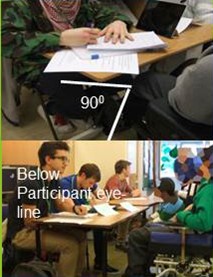Interviews involve an interviewer asking questions of an interviewee. There are three main forms of interview:
- Structured (formal ordered and unchanging questions used in quantitative surveys);
- Semi-structured (has a series of set questions, but subsequent questions asked by the interviewer to fully understand and explore the reply given by the interviewee); and,
- Unstructured (subsequent questions led by the responses of interviewee to the first asked by the interviewer to fully explore a particular line of responses). (Cohen et al 2007)
Interview technique:
- Ensure your head is below the interviewee;
- Place your body at 900 to the participant’s body;
- Non-threatening body language and voice;
- One person only to talk at any time;
- Maintenance of positive eye-contact;
- Direct communication with participants, even when supported by an advocate; and,
- Smile at appropriate points in the conversation.
When interviewing, you may also use:
- Role play
- Mood boards
- Scenario boards
- Sketch models

Useful links
ALLISON, B. and DE MONTFORT UNIVERSITY, 1996. Research skills for students. London: Kogan Page in association with De Montfort University.
Cohen, L. Mannion, L., Morrison K. 2007. Research methods in education. 6th ed. London, New York: Routledge.
TORRENS, G.E. and NEWTON, H., 2013. Getting the most from working with higher education: a review of methods used within a participatory design activity involving KS3 special school pupils and undergraduate and post-graduate industrial design students. Design and Technology Education: an international journal, 18 (1), pp. 58 – 71.
